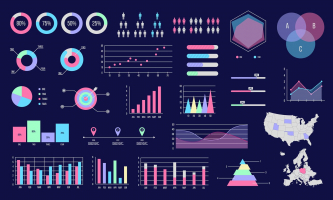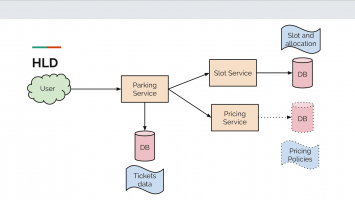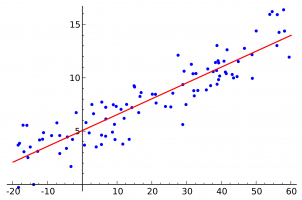Top 10 Best Online Studentized Residual Courses
Are you wondering which remote classroom to attend? You have spare time and want to broaden your horizon about a specific field of study whilst just staying ... read more...home. Thus, to satisfy the burgeoning demand for online yet qualifying courses, Toplist has compiled a rundown of the Best Online Studentized Residual Courses offered by famous companies, top organizations, and knowledgeable instructors across the globe for those who are in need!
-
The Complete Student Ministry Course 2022 is a five-week course for building a thriving student ministry at a smaller church. This is for those new to student ministry, part-time, volunteer, or bi-vocational student pastors. It will equip those who never had the opportunity to go to bible college or seminary. Industry competition is very normal, it becomes a problem when your competitors are having an advantage over you in the market that you want to enjoy. That is why The Complete Student Ministry Course 2022 teaches you to come up with various strategies that can help your venture to improve its position by using various frameworks and tools in the shared marketplace.
This course ranks 1st on the list of the best online studentized residual courses. You’ll gain how to evaluate your own strategy, as well as how to locate sources of potential competitive advantage from a perspective that encompasses the internal, external, and dynamic fit of your strategy. You’ll also learn how to enhance your ability to assess the strategic impact of the moves of your competitors and how to maintain competitive advantage, understand the general drivers that create and sustain competitive advantage, and how to identify organizational barriers to change.
By the end of this course, you will learn:
- Creating an Authentic Grace-Filled Environment
- Facilitating Real Connection
- Creating a Service that's Worth Coming to.
- Equipping Students for Success.
- Building a Dream Team.
This course offers:
- Flexible deadlines: Reset deadlines based on your availability.
- Get a Certificate when you complete
- 100% online
- Advanced level
- Approximately 7 hours to complete
- Subtitles: English
Enroll here: https://www.udemy.com/course/ultimate-small-church-student-ministry-2020/
udemy.com 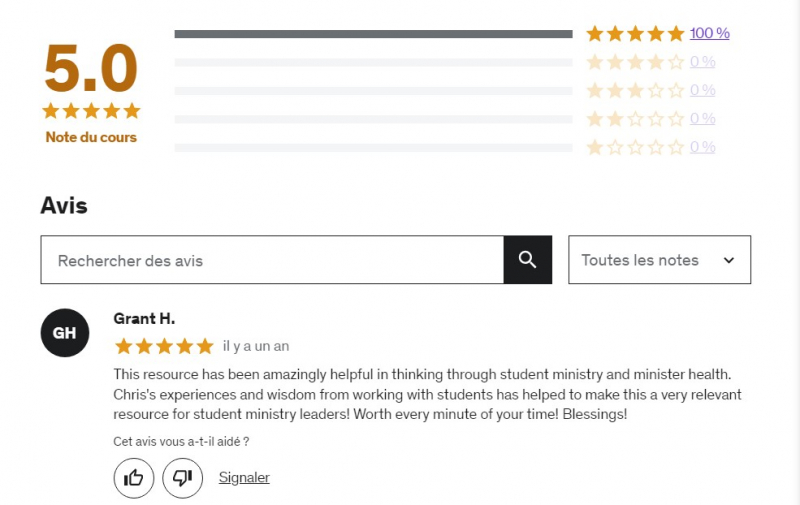
udemy.com -
Full English course for intermediate students ranks 2nd on the list of the best online studentized residual courses. A completely new approach to learning English. This is a basic course of the first 90 minutes of easy-to-understand English lessons. This course uses real examples in short films and a clear conversational methodology. The teacher is British and has 30 years of teaching experience. It is assisted by the most modern technology. Including real-life live indoor and outdoor footage.
This full English course is for intermediate English speakers. It is a course that will allow you to continue learning English and improving your English. Each lesson consists of approximately 15 to 20 minutes of material starting from the first lesson. The idea is to learn in small sessions. Don't forget that you can repeat and repeat and repeat until you feel comfortable with the new material. By simply watching the videos and copying the questions and answers, you will learn quickly. The concepts are simple and easy to follow.
By the end of this course, you will learn:
- Continue learning English and improving your English.
- Begin to learn to identify objects and to ask and answer more advanced questions.
- Learn more advanced English and start using intermediate grammar and use more complex sentences.
This course offers:
- Flexible deadlines: Reset deadlines based on your availability.
- Get a Certificate when you complete
- 100% online
- Advanced level
- Approximately 5 hours to complete
- Subtitles: English
- 1.5-hour video on demand
- 17 downloadable resources
Udemy Rating: 4.8/5
Enroll here: https://www.udemy.com/course/full-english-course-for-intermediate-students-part-one/
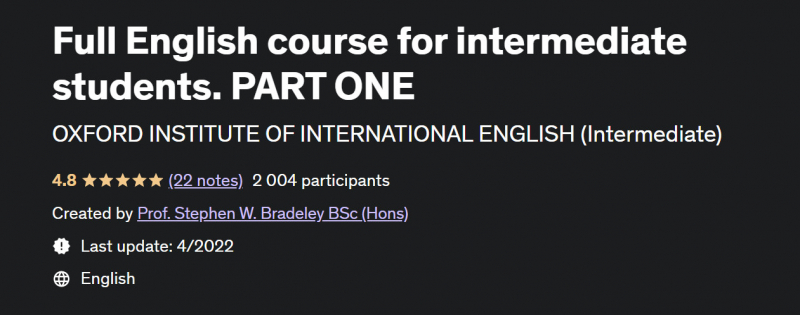
udemy.com 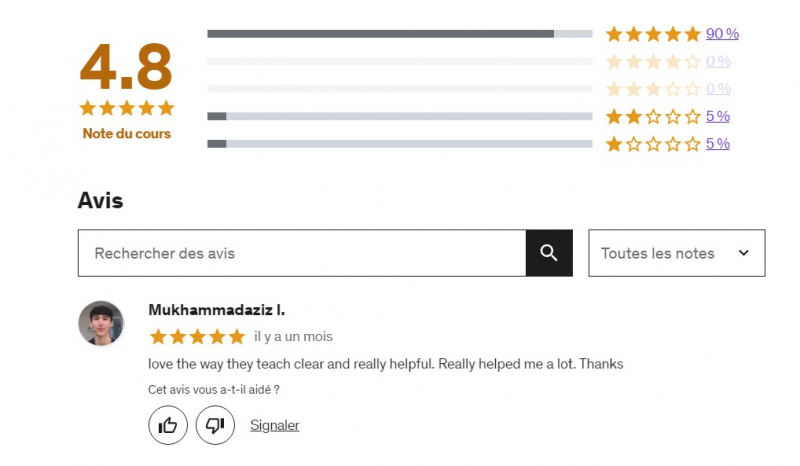
udemy.com -
An Intuitive Introduction to Probability will provide you with a basic, intuitive, and practical introduction to Probability Theory. It ranks 3rd on the list of the best online studentized residual courses. You will be able to learn how to apply Probability Theory in different scenarios and you will earn a "toolbox" of methods to deal with uncertainty in your daily life.
The Intuitive Introduction to Probability Course is split into 5 modules. In each module, you will first have an easy introduction to the topic, which will serve as a basis to further develop your knowledge about the topic and acquire the "tools" to deal with uncertainty. Additionally, you will have the opportunity to complete 5 exercise sessions to reflect on the content learned in each module and start applying your earned knowledge right away. The topics covered are: "Probability", "Conditional Probability", "Applications", "Random Variables", and "Normal Distribution". You will see how the modules are taught in a lively way, focusing on having an entertaining and useful learning experience.By the end of this course, you will be able to:
- Students will learn probability and basic techniques of data analysis and inference. Students will gain a deeper understanding of the underlying concepts.
- Calculate the Probability of X Successes in a Binomial Experiment
- Use the Classical Approach of Hypothesis Testing to Determine the Initial and Final Conclusion for a Test of Hypothesis
- Construct a Confidence Interval for the Mean or Proportion
This course offers:
- Flexible deadlines: Reset deadlines based on your availability.
- Get a Certificate when you complete
- 100% online
- Beginner level
- Approximately 30 hours to complete
- Subtitles: English
Coursera Rating: 4.8/5
Enroll here: https://www.coursera.org/learn/introductiontoprobability
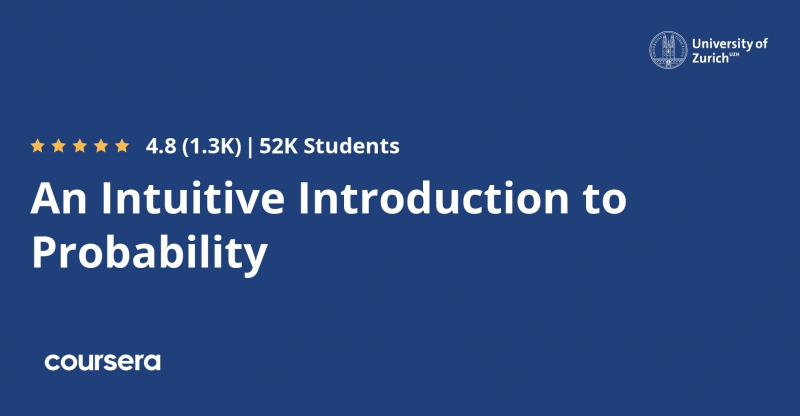
coursera.org 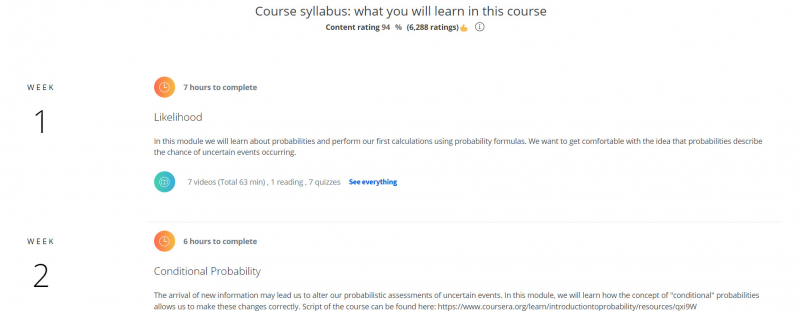
coursera.org -
In the Custom and Distributed Training with TensorFlow, you learn about distributed training and how Azure Machine Learning supports it for deep learning models. In distributed training, the workload to train a model is split up and shared among multiple mini processors, called worker nodes. These worker nodes work in parallel to speed up model training. Distributed training can be used for traditional ML models, but is better suited for computing and time-intensive tasks, like deep learning for training deep neural networks.
There are two main types of distributed training: data parallelism and model parallelism. For distributed training on deep learning models, the Azure Machine Learning SDK in Python supports integrations with popular frameworks, PyTorch and TensorFlow. Both frameworks employ data parallelism for distributed training and can leverage horovod for optimizing compute speeds. Most of these courses from Coursera are part of a particular specialization, which is a micro-credential. These specializations also include a capstone project and are geared towards in-demand technology skills. Custom and Distributed Training with TensorFlow includes extensive course content, online videos, quizzes, capstone projects at every level, and virtual classes by the best educators in the industry.
By the end of this course, you will learn:
- Learn about Tensor objects, the fundamental building blocks of TensorFlow, understand the difference between the eager and graph modes in TensorFlow, and learn how to use a TensorFlow tool to calculate gradients.
- Build your own custom training loops using GradientTape and TensorFlow Datasets to gain more flexibility and visibility with your model training.
- Learn about the benefits of generating code that runs in graph mode, take a peek at what graph code looks like, and practice generating this more efficient code automatically with TensorFlow’s tools.
- Harness the power of distributed training to process more data and train larger models, faster, get an overview of various distributed training strategies, and practice working with a strategy that trains on multiple GPU cores, and another that trains on multiple TPU cores.
This course offers:
- Flexible deadlines: Reset deadlines based on your availability.
- Shareable Certificate: Earn a Certificate upon completion
- 100% online
- Course 2 of 4 in the TensorFlow: Advanced Techniques Specialization
- Approximately 29 hours to complete
- Subtitles: English
Enroll here: https://www.coursera.org/learn/custom-distributed-training-with-tensorflow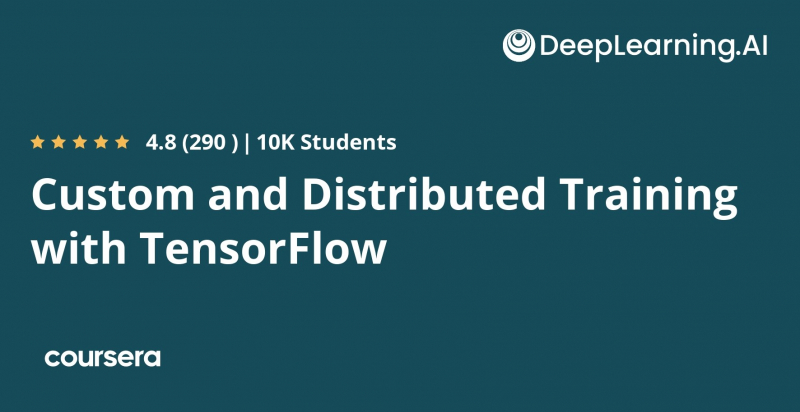
coursera.org 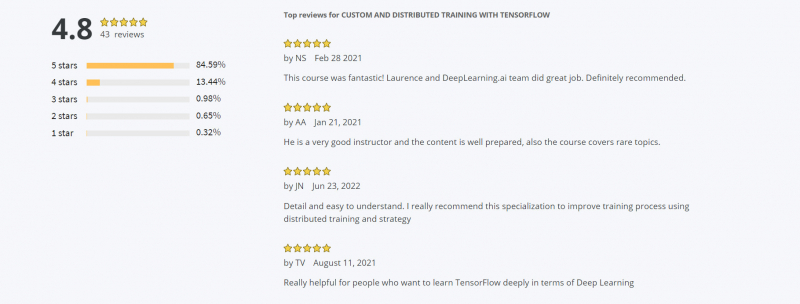
coursera.org -
The fundamentals of hotel distribution offered by ESSEC Business School is a course that ranks 5th on the list of the best online studentized residual courses. In today's hotel sector an increasingly complex network of traditional and web-based channels has to be managed to insure hotel success. Key questions include: how should you distribute over the web? What should you include on your brand.com website so people book through it? How can you maximize the potential of online travel agents (OTAs)? With the distribution environment both highly complex and constantly evolving, this course will give you a comprehensive foundation of current industry practices to help jump-start your career in this fascinating domain.For over a century, ESSEC has been developing a state-of-the-art educational program that gives the individual pride of place in its learning model, promoting the values of freedom, openness, innovation, and responsibility. Preparing future managers to reconcile personal interests with collective responsibility, giving consideration to the common good in their decision-making, and weighing economic challenges against the social costs are some of the objectives ESSEC has set for itself. The hotel business has evolved from its early days to today. Through this evolution, it has become increasingly specialized. This module of The fundamentals of hotel distribution introduces the business models, strategies for growth, levels of competition, and the biggest changes and challenges hotels have to face today.
By the end of this course, you will be able to:
- Hospitality Management
- Revenue Management
- Hospitality Management Studies
- Hotel Management
This course offers:
- Flexible deadlines: Reset deadlines based on your availability.
- Get a Certificate when you complete
- 100% online
- Course 1 of 4 in the Hospitality Management Specialization: Distribution, Revenue, and Demand Management
- Approximately 4 p.m. to complete
- Subtitles: Arabic, French, Portuguese, English, Italian, Vietnamese, German, Russian, Spanish
Coursera Rating: 4.7/5
Enroll here: https://www.coursera.org/learn/hotel-distribution
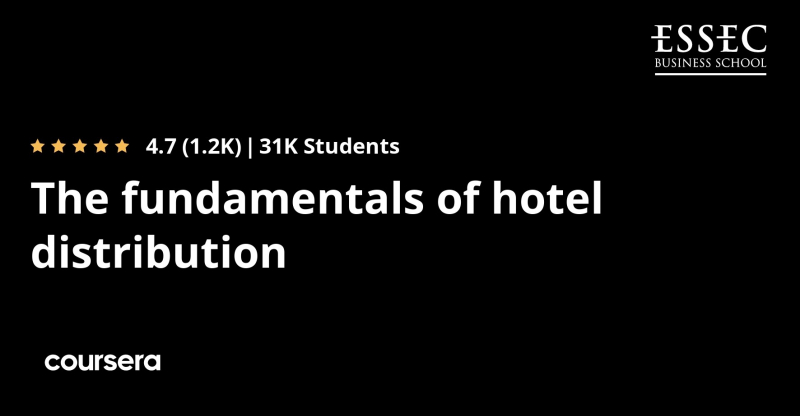
coursera.org 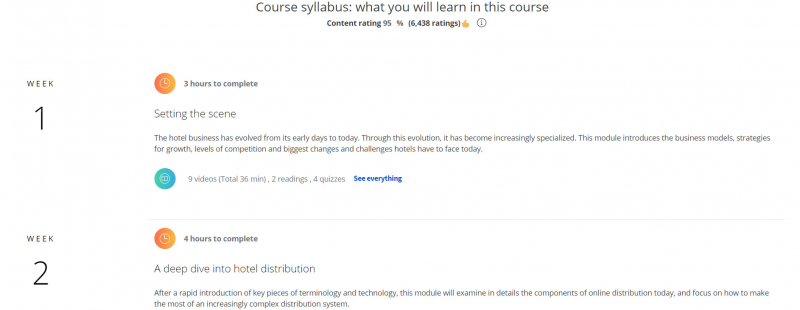
coursera.org -
Basic Data Descriptors, Statistical Distributions, and Application to Business Decisions is a course that ranks 6th on the list of the best online studentized residual courses. The ability to understand and apply Business Statistics is becoming increasingly important in the industry. A good understanding of Business Statistics is a requirement to make correct and relevant interpretations of data. Lack of knowledge could lead to erroneous decisions which could potentially have negative consequences for a firm.
This course is designed to introduce you to Business Statistics. Different categories of descriptive measures are introduced and discussed along with the Excel functions to calculate them. The notion of probability or uncertainty is introduced along with the concept of a sample and population data using relevant business examples. This leads us to various statistical distributions along with their Excel functions which are then used to model or approximate business processes. You get to apply these descriptive measures of data and various statistical distributions using easy-to-follow Excel-based examples which are demonstrated throughout the course. To successfully complete course assignments, students must have access to Microsoft Excel.
By the end of this course, you will learn:
- Get to understand, calculate and interpret various descriptive or summary measures of data
- See various applications of the Normal distribution and Fish distribution
- Understand the notion of causation versus correlation
This course offers:
- Flexible deadlines: Reset deadlines based on your availability.
- Earn a Certificate upon completion
- 100% online
- Course 2 of 5 in the Business Statistics and Analysis specialization
- Approximately 9 p.m. to finish
- Subtitles: Arabic, French, Portuguese (European), Italian, Vietnamese, German, Russian, English, Spanish
Coursera Rating: 4.7/5
Enroll here: https://www.coursera.org/learn/descriptive-statistics-statistical-distributions-business-application
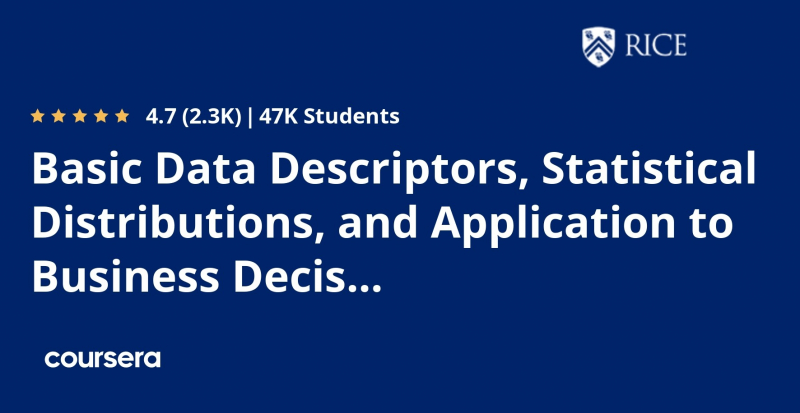
coursera.org 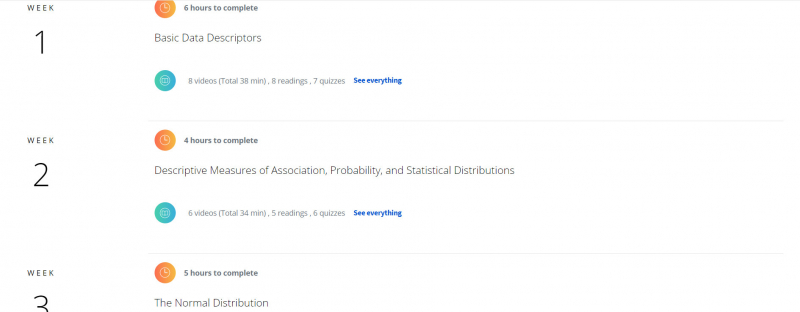
coursera.org -
The Business Statistics and Analysis Specialization is designed to equip you with a basic understanding of business data analysis tools and techniques. Informed by the world-class Data Science master's and Ph.D. course material, you'll master essential spreadsheet functions, build descriptive business data measures, and develop your aptitude for data modeling. You'll also explore basic probability concepts, including measuring and modeling uncertainty, and you'll use various data distributions, along with the Linear Regression Model, to analyze and inform business decisions. The Specialization culminates with a Capstone Project in which you'll apply the skills and knowledge you've gained to an actual business problem.
The Business Statistics and Analysis Specializations is a series of courses focused on mastering a skill. To get started, enroll directly in the Specialization or review its courses and choose the one you want to start with. When you subscribe to a course that is part of a Specialization, you are automatically subscribed to the full Specialization. It is possible to complete only one course: you can suspend your training or terminate your subscription at any time. Visit your student dashboard to track your class enrollments and progress. Each Specialization includes a hands-on project. You must successfully complete the projects to complete the Specialization and earn your Certificate. When you complete the courses and the practical project, you will earn a Certificate that you can share with potential employers and your professional network.
By the end of this course, you will learn:
- Microsoft Excel, Linear Regression
- Statistical Hypothesis Testing
- Lookup Table, Swivel Table
- Data Analysis, Statistics, Statistical Analysis, Interaction (Statistics)
- Normal Distribution and Fish distribution
- Log–Log Plot
This course offers:
- Flexible deadlines: Reset deadlines based on your availability.
- Earn a Certificate upon completion
- 100% online
- Beginner level
- Approximately 5 months to complete
- Subtitles: English, Tamil, Arabic, French, Portuguese, Italian, Vietnamese, German, Russian, Spanish
Coursera Rating: 4.7/5
Enroll here: https://www.coursera.org/specializations/business-statistics-analysis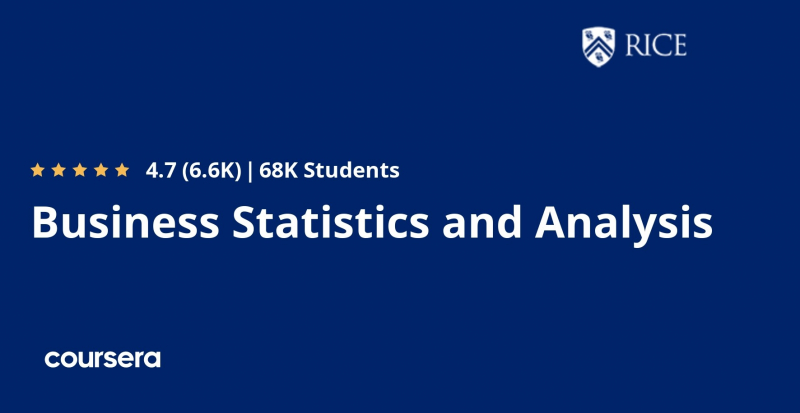
coursera.org 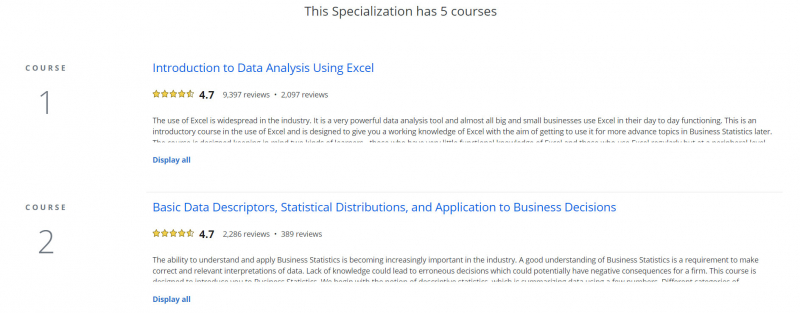
coursera.org -
Six Sigma Tools for Analysis will cover the Measure phase and portions of the Analyze phase of the Six Sigma DMAIC (Define, Measure, Analyze, Improve, and Control) process. You will learn about lean tools for process analysis, failure mode and effects analysis (FMEA), measurement system analysis (MSA), and gauge repeatability and reproducibility (GR&R), and you will be introduced to basic statistics. This course will outline useful measure and analysis phase tools and will give you an overview of statistics as they are related to the Six Sigma process.
The statistics module will provide you with an overview of the concepts and you will be given multiple example problems to see how to apply these concepts. Every module will include readings, discussions, lecture videos, and quizzes to help make sure you understand the material and concepts that are studied. Registration includes online access to course content, projects, and resources but does not include the companion text The Certified Six Sigma Handbook (2nd edition). The companion text is not required to complete the assignments. However, the text is a recognized handbook used by professionals in the field. Also, it is a highly-recommended text for those wishing to move forward in Six Sigma and eventually gain certification from professional agencies such as the American Society for Quality (ASQ).By the end of this course, you will learn:
- Statistics
- Binomial Distribution
- Data Analysis
- Causality
This course offers:
- Flexible deadlines: Reset deadlines based on your availability.
- Get a Certificate upon completion
- 100% online
- Beginner level
- Approximately 8 hours to complete
- Course 3 of 4 in the Six Sigma Yellow Belt Specialization
- Subtitles: Arabic, French, Portuguese, Italian, Vietnamese, German, Russian, Indonesian, English, Spanish, Romanian
Coursera Rating: 4.7/5
Enroll here: https://www.coursera.org/learn/six-sigma-analyze
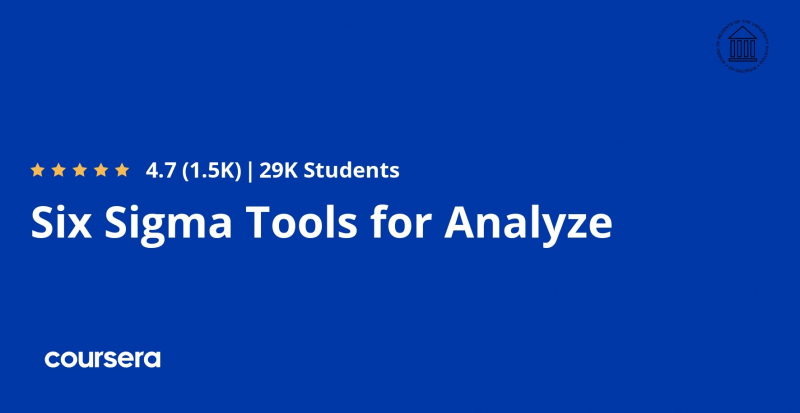
coursera.org 
coursera.org -
Bayesian Statistics: From Concept to Data Analysis is a course that introduces the Bayesian approach to statistics, starting with the concept of probability and moving to the analysis of data. They will learn about the philosophy of the Bayesian approach as well as how to implement it for common types of data. They will also compare the Bayesian approach to the more commonly-taught Frequentist approach, and see some of the benefits of the Bayesian approach. In particular, the Bayesian approach allows for better accounting of uncertainty, results that have more intuitive and interpretable meaning, and more explicit statements of assumptions.
Bayesian Statistics Specialization combines lecture videos, computer demonstrations, readings, exercises, and discussion boards to create an active learning experience. For computing, you have the choice of using Microsoft Excel or the open-source, freely available statistical package R, with equivalent content for both options. The lectures provide some of the basic mathematical development as well as explanations of philosophy and interpretation. Completion of this course will give you an understanding of the concepts of the Bayesian approach, understanding the key differences between Bayesian and Frequentist approaches, and the ability to do basic data analyses.
By the end of this course, you will be able to:
- Statistics
- Bayesian Statistics
- Bayesian Inference
- R Programming
This course offers:
- Flexible deadlines: Reset deadlines based on your availability.
- Get a Certificate upon completion
- 100% online
- Intermediate level
- Course 1 of 5 in the Bayesian Statistics Specialization
- Approximately 12 hours to complete
- Subtitles: Arabic, French, Portuguese, Italian, Vietnamese, German, Russian, English, Spanish
Coursera Rating: 4.6/5
Enroll here: https://www.coursera.org/learn/bayesian-statistics
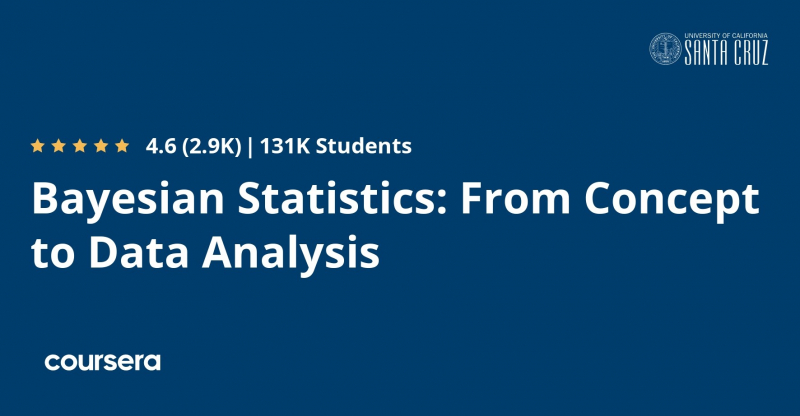
coursera.org 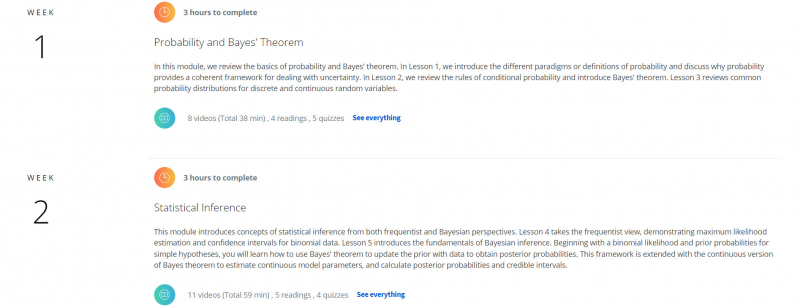
coursera.org -
Six Sigma Yellow Belt Specialization is for you if you are looking to learn more about Six Sigma or refresh your knowledge of the basic components of Six Sigma and Lean. Six Sigma skills are widely sought by employers both nationally and internationally. These skills have been proven to help improve business processes, performance, and quality assurance. In this specialization, you will learn proven principles and tools specific to six sigma and lean.
The Six Sigma Yellow Belt Specialization is a sequential, linear designed specialization that covers the introductory level content (at the "yellow belt" level) of Six Sigma and Lean. Yellow Belt knowledge is needed before advancing to Green Belt (which is a second specialization offered here on Coursera by the USG). Green Belt knowledge is needed before moving to a Black Belt. It should be noted that completing either the Yellow Belt or Green Belt Specializations does not give the learner "professional accreditation" in Six Sigma. However, successful completion will assist in better preparation for such professional accreditation testing. While uncertainty makes decision-making difficult, it does at least make life exciting! If the entire future was known in advance, there would never be an element of surprise. Whether a good future or a bad future, it would be a known future.
By the end of this course, you will be able to:
- Cover the Measure phase and portions of the Analyze phase of the Six Sigma DMAIC (Define, Measure, Analyze, Improve, and Control) process.
- Become familiar with project management tools, you will be introduced to statistics and understand its significance to Six Sigma
- Have more opportunities to participate in discussions and peer review exercises to give you the opportunity to apply the material to your daily life.
This course offers:
- Flexible deadlines: Reset deadlines based on your availability.
- Earn a Certificate upon completion
- 100% online
- Beginner level
- Approximately 5 months to complete
- Subtitles: Arabic, French, Portuguese, Italian, Vietnamese, German, Russian, English, Spanish
Enroll here: https://www.coursera.org/specializations/six-sigma-fundamentals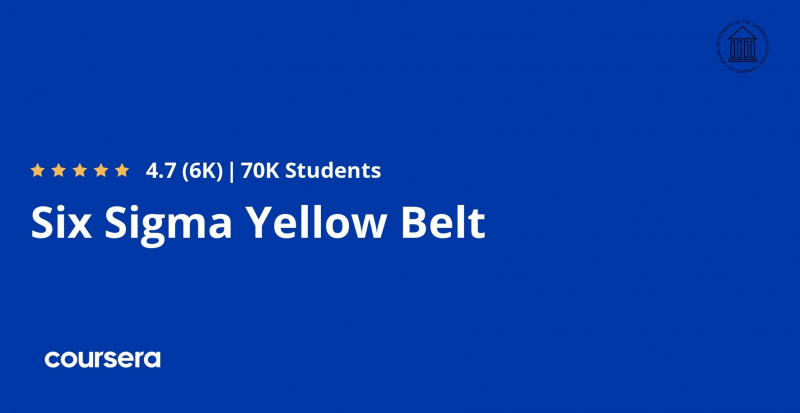
coursera.org 
coursera.org - Cover the Measure phase and portions of the Analyze phase of the Six Sigma DMAIC (Define, Measure, Analyze, Improve, and Control) process.






















